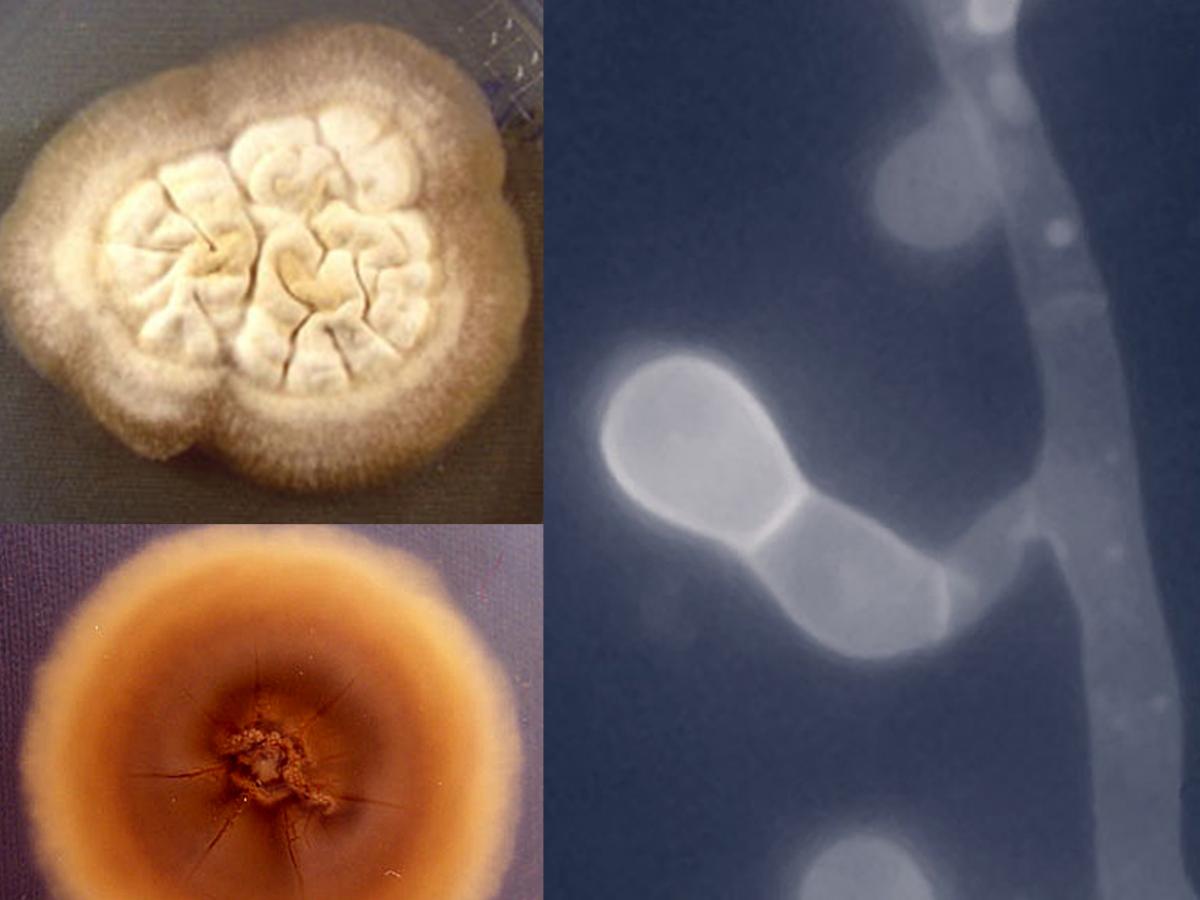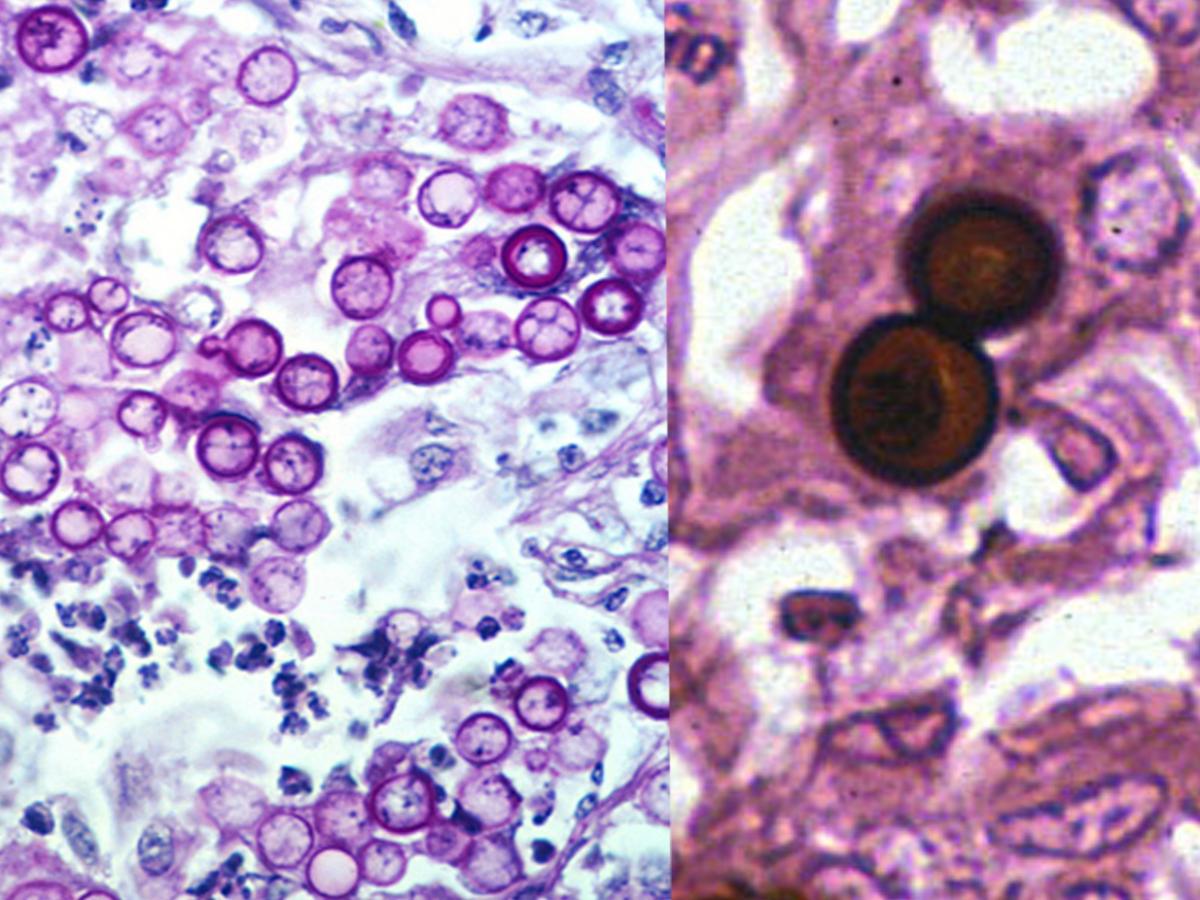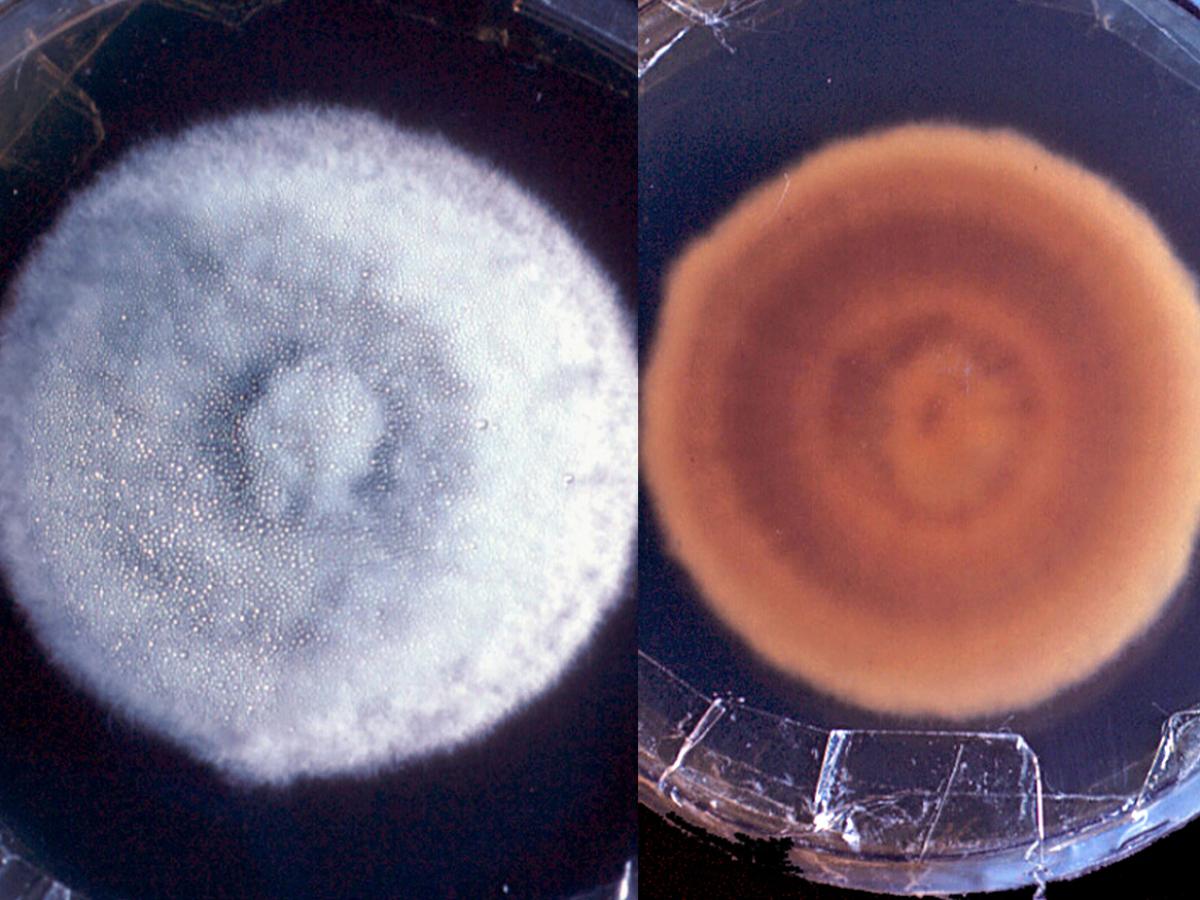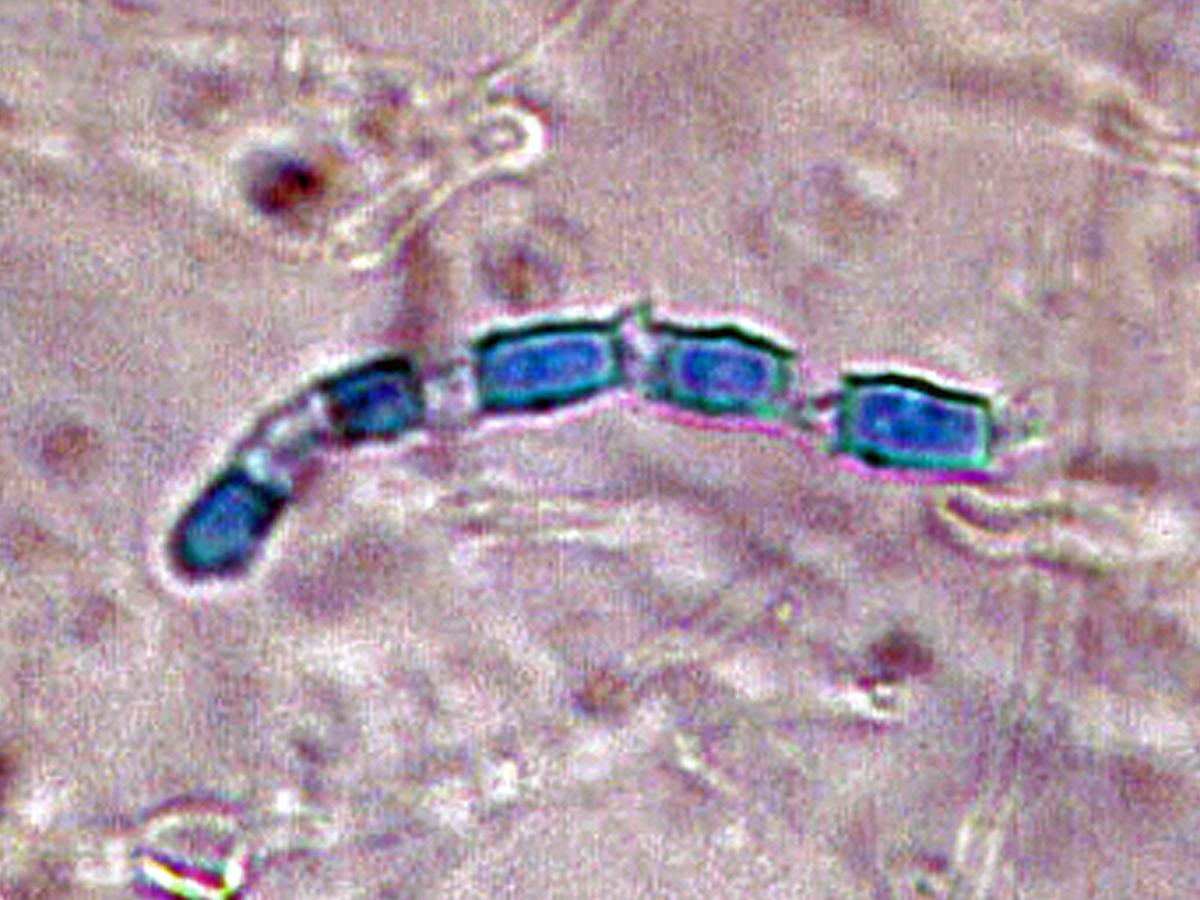Dimorphic Fungal Pathogens
These are fungal infections of the body caused by fungal pathogens which can overcome the physiological and cellular defences of the normal human host by changing their morphological form.
They are geographically restricted and the primary site of infection is usually pulmonary, following the inhalation of conidia.

Exoantigen immunodiffusion plate showing positive identification of Histoplasma capsulatum. Note: H and M bands of identification; EX = culture filtrate; H = Histoplasma antibody and antigen, C = Coccidioides antibody and antigen; B = Blastomyces antibody and antigen.
Note: DNA sequencing is now becoming the method of choice to minimise staff exposure to the infectious propagules.
Traditionally, positive identification required conversion of the mould form to the yeast phase by growth at 37C on enriched media, however for laboratory safety, culture identification by either exoantigen test or DNA sequencing is now preferred.
WARNING: RG-3 organisms.
Cultures of these fungi represent a severe biohazard to laboratory personnel and must be handled with extreme caution in an appropriate pathogen handling cabinet.
Species descriptions
-
Blastomyces dermatitidis
At present the genus Blastomyces contains two species, Blastomyces dermatitidis and Blastomyces gilchristi, which are morphologically identical but distinguishable by sequence analysis of the ITS region (Brown et al.2013). B. dermatitidis lives in soil and in association with decaying organic matter such as leaves and wood. It is the causal agent of blastomycosis a chronic granulomatous and suppurative disease, having a primary pulmonary stage that is frequently followed by dissemination to other body sites, typically the skin and bone. Although the disease was long thought to be restricted to the North American continent, in recent years autochthonous cases have been diagnosed in Africa, Asia and Europe.
WARNING: RG-3 organism.
Cultures of B. dermatitidis represent a biohazard to laboratory personnel and must be handled in a Class II Biological Safety Cabinet (BSCII).
Blastomyces dermatitidis culture and microscopy showing one-celled, smooth-walled conidia borne on short lateral to terminal hyphal branches (images provided by Jon Biehle, Dept. of Pathology, Creighton University, Omaha, NE, USA).
Morphological description:
Colonies at 25C have variable morphology and growth rate. They may grow rapidly, producing a fluffy white mycelium or slowly as glabrous, tan, nonsporulating colonies. Growth and sporulation may be enhanced by yeast extract. Most strains become pleomorphic with age. Microscopically, hyaline, ovoid to pyriform, one-celled, smooth-walled conidia (2-10 µm in diameter) of the Chrysosporium type, are borne on short lateral or terminal hyphal branches.Colonies on blood agar at 37C are wrinkled and folded, glabrous and yeast-like. Microscopically, the organism produces the characteristic yeast phase seen in tissue pathology; ie. B. dermatitidis is a dimorphic fungus.
Comment:
In the past, conversion from the mould form to the yeast form was necessary to positively identify this dimorphic pathogen from species of Chrysosporium or Sepedonium. However, culture identification by exoantigen test and/or molecular methods is now preferred to minimise manipulation of the fungus.Key features:
Clinical history, tissue pathology, culture identification by positive exoantigen test and/or by molecular methods.
Tissue section showing large, broad-base, unipolar budding yeast-like cells of Blastomyces dermatitidis.
Histopathology:
Blastomyces dermatitidis tissue sections show large, broad-based, unipolar budding yeast-like cells, which may vary in size from 8-15 µm, with some larger forms up to 30 µm in diameter. Tissue sections need to be stained by Grocott’s methenamine silver method to clearly see the yeast-like cells, which are often difficult to observe in H&E preparations.Molecular diagnostics:
A DNA probe assay (AccuProbe, Gen-Probe, Inc., San Diego, CA) for identification of B. dermatitidis in clinical isolates is available (Scalarone et al. 1992 and Padhye et al. 1994b). However this has limited application as it can be used only with pure cultures of B. dermatitidis (yeast or mould) (Sidamonidze et al. 2012). Several conventional PCR assays have been developed for the identification of B. dermatitidis from clinical specimens (Bialek et al. 2003) and soil (Burgess et al. 2006). Sidamonidze et al. (2012) developed a real-time PCR targeting the BAD1 (formerly known as WI-1) gene for the identification of B. dermatitidis in culture and tissue and Morjaria et al. (2015) used rDNA sequencing for identification from paraffin embedded tissue.References:
McGinnis (1980), Chandler et al. (1980), Kaufman and Standard (1987), Rippon (1988), Brown et al. (2013).Antifungal Susceptibility: B. dermatitidis limited data available (Sugar and Liu 1996, Espinel-Ingroff et al. 2001, Espinel-Ingroff 2003, Gonzales et al. 2005 and Sabatelli et al. 2006); MIC µg/mL.
Antifungal susceptibility testing not recommended.
Antifungal Range MIC90 Antifungal Range MIC90 FLU 0.125-64 4-16 AMB 0.03-1 0.5 ITRA 0.03->16 0.125-2 VORI 0.03-16 0.25 POSA 0.03-2 0.125 CAS 0.5-8 2 -
Coccidioides immitis/posadasii
WARNING: RG-3 organism.
Cultures of Coccidioides immitis/posadasii represent a severe biohazard to laboratory personnel and must be handled with extreme caution in Class II Biological Safety Cabinet (BSCII). Cultures can grow rapidly (within 48 hours on blood agar) and are often first encountered in routine microbiology laboratories, rather than specialised and contained mycology laboratories. Therefore routine bacteriology staff should be made aware of the risks in handling this organism and steps should be taken to limit these risks.
Coccidioides immitis tissue morphology showing typical endosporulating spherules. Young spherules have a clear centre with peripheral cytoplasm and a prominent thick-wall. Endospores (sporangiospores) are later formed within the spherule by repeated cytoplasmic cleavage. Rupture of the spherule releases endospores into the surrounding tissue where they re-initiate the cycle of spherule development.
Coccidioides immitis has been separated into two distinct species: C. immitis and C. posadasii (Fisher et al. 2002). The two species are morphologically identical and can be distinguished only by genetic analysis and different rates of growth in the presence of high salt concentrations (C. posadasii grows more slowly). C. immitis is geographically limited to California’s San Joaquin Valley region and Mexico, whereas C. posadasii is found in California, Arizona, Texas, Mexico and South America..

Culture of Coccidioides immitis
Morphological description:
Colonies of C. immitis and C. posadasii grown at 25C may initially be moist and glabrous, but rapidly become suede-like to downy, greyish-white with a tan to brown reverse. However, considerable variation in growth rate and culture morphology has been noted. Microscopy shows typical single-celled, hyaline, rectangular to barrel-shaped, alternate arthroconidia, 2.5-4 x 3-6 µm in size, separated from each other by a disjunctor cell.
The closely related non-pathogenic soil fungus, Malbranchea spp. produces morphologically similar arthroconidia, and this organism may be used as a surrogate for laboratory investigations and training. Other soil fungi such as Gymnoascus spp. also produce similar arthroconidia.Comment:
Coccidioides immitis and C. posadasii are dimorphic fungi, existing in living tissue as spherules and endospores, and in soil or culture in a mycelial form. Despite its dimorphism, the ‘spherule phase’ will not be observed using routine laboratory procedures,and inducing this phaseshould not be attempted.
Culture identification by either exoantigen test or DNA sequencing is preferred to minimise exposure to the infectious propagule.
Microscopy shows typical single-celled, hyaline, rectangular to barrel-shaped, alternate arthroconidia, 2.5-4 x 3-6 µm in size, separated from each other by a disjunctor cell.
Key features:
Clinical history, tissue pathology, culture identification by ITS sequence analysis.Molecular identification:
In endemic areas a DNA probe for recognition of the species is commercially available (Padhye et al. 1994b). ITS sequencing is recommended for differentiation of species (Tintelnot et al. 2007, Binnicker et al. 2011).References:
Ajello (1957), Steele et al. (1977), McGinnis (1980), Chandler et al. (1980), Catanzaro (1986), Rippon (1988), de Hoog et al. (2015), Fisher et al. (2002).
Antifungal susceptibility: Coccidioides immitis (Ramani and Chaturvedi 2007); MIC µg/mL.
Antifungal susceptibility testing not recommended.
No ≤0.03 0.06 0.125 0.25 0.5 1 2 4 8 16 ≥32 AmB 45 7 25 8 4 1 FLU 45 1 4 10 27 3 VORI 45 13 9 15 8 POSA 45 25 13 3 4 ITRA 45 23 22 -
Histoplasma capsulatum
WARNING: RG-3 organism.
Cultures of Histoplasma capsulatum represent a severe biohazard to laboratory personnel and must be handled with extreme caution in a Class II Biological Safety Cabinet (BSCII).Histoplasma capsulatum has a worldwide distribution, however the Mississippi-Ohio River Valley in the USA is recognised as a major endemic region. Environmental isolations of the fungus have been made from soil enriched with excreta from chicken, starlings and bats.
Histoplasma capsulatum has recently been subdivided into a number of molecular siblings (Sepulveda et al., 2017), which in part show extensive hybridization (Maxwell et al., 2018) and which may be difficult to distinguish in practice (de Almeida et al., 2020). On a global scale, and particularly in South America, the Histoplasma capsulatum complex shows enormous diversity (Rodrigues et al., 2020a). Patients may be infected by several genotypes (Damasceno et al., 2019)
Histoplasmosis is an intracellular mycotic infection of the reticuloendothelial system caused by the inhalation of the fungus. Approximately 95% of cases of histoplasmosis are inapparent, subclinical or benign. The remaining 5% of cases may develop chronic progressive lung disease, chronic cutaneous or systemic disease or an acute fulminating fatal systemic disease. All stages of this disease may mimic tuberculosis. Sporadic cases have been reported in Australia.

Culture of Histoplasma capsulatum showing mould-like growth at 25C and yeast-like growth at 37C.
Morphological description:
Histoplasma capsulatum exhibits thermal dimorphism growing in living tissue or in culture at 37C as a budding yeast-like fungus and in soil or culture at temperatures below 30C as a mould.Colonies at 25C are slow growing, white or buff-brown, suede-like to cottony with a pale yellow-brown reverse. Other colony types are glabrous or verrucose, and a red pigmented strain has been noted (Rippon, 1988). Microscopic morphology shows the presence of characteristic large, rounded, single-celled, 8-14 µm in diameter, tuberculate macroconidia formed on short, hyaline, undifferentiated conidiophores. Small, round to pyriform microconidia, 2-4 µm in diameter, borne on short branches or directly on the sides of the hyphae may also be present.
Colonies at 37C grown on brain heart infusion (BHI) agar containing blood are smooth, moist, white and yeast-like. Microscopically, numerous small round to oval budding yeast-like cells, 3-4 x 2-3 µm in size are observed.

Large, rounded, single-celled, tuberculate macroconidia and small microconidia of H. capsulatum.
Three varieties of Histoplasma capsulatum are recognised, depending on the clinical disease: var. capsulatum is the common cause of histoplasmosis; var. duboisii is the African type and var. farciminosum causes lymphangitis in horses. Histoplasma isolates may also resemble species of Sepedonium and Chrysosporium. Traditionally, positive identification required conversion of the mould form to the yeast phase by growth at 37C on enriched media, however for laboratory safety, culture identification by either exoantigen test or DNA sequencing is now preferred.
Key features:
Clinical history, tissue morphology, culture morphology and positive exoantigen test or DNA sequencing.Molecular identification:
Eliaset al. (2012) developed a multiplex-PCR for identification from cultures. Scheel et al. (2014) developed a loop-mediated isothermal amplification (LAMP) assay for detection directly in clinical samples which is affordable and useful in resource poor facilities. ITS sequencing may also be used for accurate identification (Estrada-Bárcenas et al. 2014, Irinyi et al. 2015).MALD-ToF MS:
Valero et al. (2018) developed a reference database for the identification of Histoplasma capsulatum.References:
McGinnis (1980), Chandler et al. (1980), George and Penn (1986), Rippon (1988), de Hoog et al. (2000, 2015).Antifungal Susceptibility: Histoplasma capsulatum limited data available (Espinel-Ingroff 2003, Gonzalez et al. 2005, Sabatelli et al. 2006, Brilhante et al. 2012, Kathuria et al. 2014); MIC µg/mL.
Antifungal susceptibility testing not recommended.
Antifungal Filamentous form Yeast form Range MIC90 Range MIC90 AMB ≤0.03-0.5 0.5 0.03-0.5 0.25 FLU 1-125 16 2-8 8 ITRA ≤0.03-1 0.125 (1) ≤0.03-0.25 0.125 VORI ≤0.03-2 0.25 (1) ≤0.03-0.5 0.5 POSA ≤0.03-2 0.125 (2) 0.03-0.5 0.25 -
Paracoccidioides brasiliensis/lutzii
WARNING: RG-3 organism.
Cultures of Paracoccidioides brasiliensis/lutzii represent a biohazard to laboratory personnel and should be handled with extreme caution in a Class II Biological Safety Cabinet (BSCII).Recently P. brasiliensis has been recognised as two species: P. brasiliensis and P. lutzii (Teixeira et al. 2014, Theodoro et al.2012). P. brasiliensis/lutzii is geographically restricted to areas of South and Central America. The two species are morphologically very similar; conidia of P. lutzii are elongated whereas those from P. brasiliensis are pyriform. Molecular confirmation is recommended.
Molecular identification:
ITS sequencing is recommended (Imai et al. 2000).
Multiple, narrow base, budding yeast cells "steering wheels"of Paracoccidioides brasiliensis.
Morphological description:
Colonies grown at 25C are slow growing and variable in morphology. Colonies may be flat, wrinkled and folded, glabrous, suede-like or downy in texture, white to brownish with a tan or brown reverse. Microscopically, a variety of conidia may be seen, including pyriform microconidia, chlamydospores and arthroconidia. However, none of these are characteristic of the species, and most strains may grow for long periods of time without the production of conidia.On blood agar at 37C, the mycelium converts to the yeast phase and colonies are white to tan, moist and glabrous and become wrinkled, folded and heaped. Microscopically, numerous large, 20-60 μm, round, narrow base budding yeast cells are present. Single and multiple budding occurs, the latter are thick-walled cells that form the classical “steering wheel” or “mickey mouse” structures that are diagnostic for this fungus, especially in methenamine silver stained tissue sections.
Key features:
Clinical history, tissue pathology, culture identification with conversion to yeast phase at 37C, however molecular identification is now recommended.References:
McGinnis (1980), Chandler et al. (1980), Rippon (1988), de Hoog et al. (2000, 2015).Antifungal Susceptibility: Paracoccidioides brasiliensis very limited data (McGinnis et al. 1997). MIC µg/mL.
Antifungal susceptibility testing not recommended.
Antifungal Range Antifungal Range FLU <0.125-64 AMB 0.125-4 ITRA <0.03->1 VORI <0.03-2
